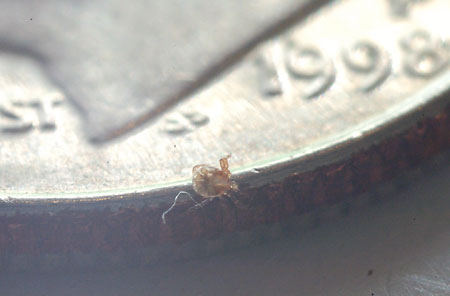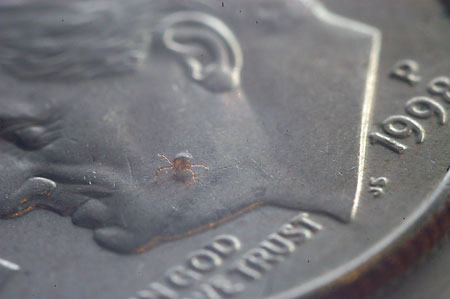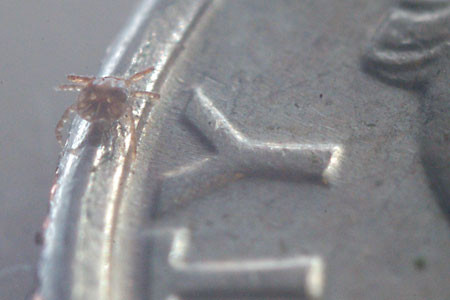



---
| H.B. Hungerford Entomologist |
The above pictures were taken August 8, 2004 at about 11:30 PM. I had been out photographing wildflowers in New Jersey's pine-barrens that morning with Steve Greer, getting home in the early afternoon. I had showered, done chores, etc. and finally, I had gone to bed. A while after going to bed, I noticed a significant itching on one foot. Before scratching, I turned on a light and saw, to my dismay, a tiny black spot right where the itching was occuring.
I have been wanting to see if I could photograph a chigger so this appeared to be the perfect opportunity. I scraped the 'black dot' off my foot and deposited it on the bathroom vanity and waited to see if it still moved. It moved. I ran and got my loop so that I could see it, I had never actually seen one until this time. (The normal response to seeing a chigger is a frantic effort to reduce the number of bites to a few as possible as we know that a torture session is in our future.) I quickly gathered up a dime to use as a size comparison stage and the needed camera gear.
These shots were taken with my 60mm micro lens, fully extended (1:1) plus 56mm of additional extension tubing. This gives a wee bit less than 2 times magnification at the film (sensor). DSC_4821 is not cropped and is just resized down to a reasonable size for web use. DSC_4815, DSC_4825, and DSC_4832 are cropped from the original capture width of 3008 to 1780, 1071, 1440 respectively, providing additional 'digital zoom' magnification.
The following are excerps from web page;
http://news.uns.purdue.edu/UNS/html3month/010716.Gibb.chiggers.html
|
... "They crawl up to the highest point on a plant and wait for an animal or person to walk by," Gibb says. "Then they fall onto a person, usually landing on the shoes or lower pantlegs, and then begin crawling up the body looking for a place to bite." Gibb says people can prevent bites by avoiding walking through tall grasses or shrubs, and staying on paths. "A lot of chiggers fall on the shoes and pantlegs, so if you’re going to use repellents I’d concentrate on that area," Gibb says. "You should tuck your pants into your socks, and then spray repellent on that area. It’s always best to avoid putting insect repellent on bare skin." ... • Chiggers aren't insects, but arachnids, just like spiders and scorpions. They are a type of mite related to ticks. "Chiggers is a common name we give to the larvae of several species of mite," Gibb says. • Sometimes tiny red mites are seen, especially on light-colored concrete. These are adult chiggers, which don't bite people, but instead feed on insect eggs and other insects. The chigger larvae are much smaller than the adults– half a dozen of them could fit on the period at the end of this sentence. Chigger larvae can scarcely be been seen without a magnifying glass. • Although adult chiggers have eight legs, when they are in their biting larval stage they have just six. And unlike ticks, chiggers don't carry Lyme disease or Rocky Mountain spotted fever. • Chiggers aren't really good at biting, and can bite only thin skin, which is why they bite children or women more than men. They like to bite in soft, light and moist areas of the body where the sun and weather haven't made the skin tough and dry. These are places where chiggers are least welcome. • Chiggers don't burrow into the skin. Instead they pierce a skin cell with their mouths. Their saliva contains an enzyme that causes the skin cell wall to liquefy. The body's immune system reacts to the foreign enzyme resulting in a hard, red wall at the spot of the bite. The chigger capitalizes on this – it uses this round wall, which is called a stylostome, as a straw. After the chigger has had its fluid meal, it drops off. • In medical terms, these hard, red welts are called papules. A bite will begin itching three to six hours after a chigger has bitten the skin. "At that time, the chigger is long gone," Gibb says. "By the time you begin to itch, it's too late to prevent the chigger from biting." The bite will develop a red circle, or welt, within 10 to 16 hours, and will continue to itch for up to two days or more, depending on the individual's reaction. For someone with dozens of bites, this is truly an unpleasant experience. "If you absolutely must call in sick to work because of chigger bites, tell the boss that you have been diagnosed with arachnid papules," Gibb suggests, tongue-in-cheek. "That is going to sound much worse than saying you have a bunch of chigger bites." • Because chiggers cannot hold on well, they are easy to remove. Taking a shower with plenty of sudsy soap will remove them. "They don’t hang on people very well because we don’t have fur. To keep from falling off, they have to get in areas where clothing fits tight, like the tops of socks, the groin area, at the waistband, or in the armpits where shirt sleeves fit tightly," Gibb says. "So if you want to avoid chigger bites while picking raspberries, doing it naked may help," he jokes. • People often see a red dot in the middle of a chigger bite, and assume that the chigger has burrowed into the skin. However, that red dot is actually the stylostome. "There are mites, such as the scabies mite, that burrow into the skin, but the chigger doesn't," Gibb says. "People sometimes resort to strange chigger remedies such as coating their bites with Vaseline or nail polish in an effort to suffocate the chigger. In fact, by the time the bite begins itching, the chigger has long since dropped off. You can't kill something that’s not there. The itch is simply our bodies' reaction to the bite." • Sometimes the bite forms a white cap, which is the top of the stylostome. Scratching this cap off often causes a drop or two of the liquid inside the bite to ooze out. Scratching the cap off also can result in an infection. ... Sources: Tim Gibb, |